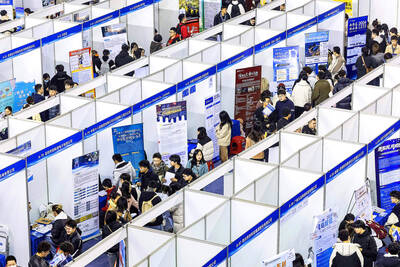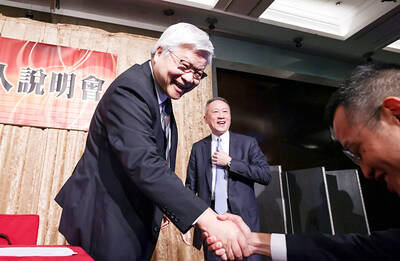Hedge funds in Asia, which navigated turbulent markets to post gains last year, had nowhere to hide last month.
As global stocks, currencies, commodities and risky bonds were roiled in a renewed frenzy of selling last month, hedge funds, including those from Quam Asset Management Ltd and Greenwoods Asset Management Ltd, fell more than 10 percent, while one from Springs Capital fell more than 20 percent.
As a group, Asia-focused hedge funds declined 3.1 percent, their worst start to a year since 2008, according to Singapore-based Eurekahedge Pte.
About 81 percent of hedge funds actively reporting to the Asia Long-Short Equities category had negative returns last month, the data show.
“January was a bloodbath to the whole world,” Chris Choy (蔡光華), chief investment officer for Quam Ltd’s (華富) China Focus Segregated Portfolio in Hong Kong, said in an e-mail.
Unless one had a “crystal ball,” it was very difficult to avoid losses, said Choy, whose US$126 million Quam China Focus fund fell 16.7 percent last month.
Hedge funds in Asia averted losses last year even as high-profile counterparts in other parts of the world were stymied amid volatile markets. That is proving to be a challenge so far this year, as fears about a global slowdown and a further decline in oil prices spurred an investor flight to safety.
The selloff wiped out more than US$7 trillion in stock market value worldwide last month, with the Shanghai Composite Index declining 23 percent and the Standard & Poor’s 500 Index sliding 5.1 percent. Oil prices slumped to a 12-year low near US$26 a barrel and losses in high-yield bonds deepened following a drop last year.
Last month was “exceptional in terms of the speed and ferocity of the declines in many markets and was in some ways reminiscent of early 2009 in the urgency of the selling,” Geoffrey Barker, who manages the Counterpoint Asian Macro Fund in Hong Kong, wrote in an investor letter.
The Counterpoint fund, which managed US$109 million as of Feb. 1, declined 3.2 percent last month, according to the letter.
Barker, a former HSBC Holdings PLC economist who manages the fund with City Financial Investment Co (Hong Kong), wrote that wrong-way bets on stocks hurt the fund and reverting to bearish wagers backfired after a rally following the unexpected cutting of interest rates by the Bank of Japan. Long positions in zinc, nickel, copper and rubber also detracted from performance.
Springs China Opportunities Fund lost nearly 24 percent last month, according to an estimate sent to investors, as the Shanghai gauge’s decline. The fund started in September 2007, when the index was trading at nearly twice its current value, and has generated a nearly 19 percent annualized return through the end of last year.
Springs is one of the few hedge funds managed outside China that focuses on the country’s domestic stock market.
Domestic class-A shares, which plunged more sharply last month than Hong Kong and US-listed Chinese shares, account for about 80 percent of investments and the stock picker uses little borrowing to enhance returns, a person with knowledge of the matter said.
Springs told investors that last month’s selloff was largely triggered by the index circuit breaker which has since been scrapped and that it sees many opportunities among A-shares, said the person, who asked not to be identified as the fund is private.
Greenwoods Asset Management’s (景林) Golden China fund, which manages more than US$1.7 billion, lost 11 percent, according to data compiled by Bloomberg. The fund, led by George Jiang (蔣錦志), was among the top performers last year. Jiang and Joseph Zeng (曾曉鬆), a partner at Greenwoods, said in an e-mail that the market volatility has given the firm plenty of investment opportunities.
“We would rather see a year started with a big correction for fundamental investors to buy on dips, rather than a year started with a big rally at the beginning and then tumbled,” Zeng said in the e-mail.
Wykeham Capital’s Asia Value Fund dropped 9.2 percent, said Howel Thomas, the firm’s Hong Kong-based portfolio manager. The fund gained 20 percent last year, bringing its annualized returns to 21 percent since its April 2009 inception, he said.
This month, the fund has gained 5.3 percent through Tuesday, paring its year-to-date decline to 4.3 percent, Thomas said.
The fund, which focuses on small-cap stocks listed in Hong Kong, received allocations from two new investors at the end of December last year, bringing its assets under management to US$25 million.
The FengHe Asia Fund, managed by F&H Fund Management Pte, fell 3.8 percent, with tumbling A-shares hurting performance, according to Rebecca Walters, the firm’s chief operating officer.
John Wu (吳炯), who was the 19th person hired by Alibaba Group Holding Ltd (阿里巴巴), started Singapore-based F&H Fund Management in 2010 with Matt Hu (胡猛), a former portfolio manager at China Securities Ltd and cofounder of Taifook Century Asset Management. FengHe Asia gained 24 percent last year.
Some funds managed to eke out gains. The Athos Asia Event Driven Fund, which had about US$146 million as of the end of last month, rose 0.08 percent last month, according to a letter to investors. The fund, led by chief investment officer Matthew Moskey and Fred Schulte-Hillen, returned 9.6 percent on an annualized basis from its inception in April 2012 through the end of December last year.
Hedge funds investing in Japan, which as a group rose last year, were also not immune to losses in January as the nation’s stocks tumbled along with those in the rest of the world. As a group, Japan-focused hedge funds declined 2.1 percent last month, according to data from Eurekahedge.
Asuka Asset Management Co’s three hedge funds are all in the red so far this year, according to Mariko Seki, who works in the US$275 million firm’s investor relations department.
Asuka Japanese Equity Long Short Strategy fell 6.1 percent last month and Asuka Opportunities Strategy slid 3.2 percent, Seki said.
Toshihiro Hirao is the portfolio manager for both funds.
Asuka Value Up Strategy, the firm’s small and mid-cap focused activist fund managed by Yosuke Mitsusada, declined 3.4 percent.

Stephen Garrett, a 27-year-old graduate student, always thought he would study in China, but first the country’s restrictive COVID-19 policies made it nearly impossible and now he has other concerns. The cost is one deterrent, but Garrett is more worried about restrictions on academic freedom and the personal risk of being stranded in China. He is not alone. Only about 700 American students are studying at Chinese universities, down from a peak of nearly 25,000 a decade ago, while there are nearly 300,000 Chinese students at US schools. Some young Americans are discouraged from investing their time in China by what they see

MAJOR DROP: CEO Tim Cook, who is visiting Hanoi, pledged the firm was committed to Vietnam after its smartphone shipments declined 9.6% annually in the first quarter Apple Inc yesterday said it would increase spending on suppliers in Vietnam, a key production hub, as CEO Tim Cook arrived in the country for a two-day visit. The iPhone maker announced the news in a statement on its Web site, but gave no details of how much it would spend or where the money would go. Cook is expected to meet programmers, content creators and students during his visit, online newspaper VnExpress reported. The visit comes as US President Joe Biden’s administration seeks to ramp up Vietnam’s role in the global tech supply chain to reduce the US’ dependence on China. Images on

New apartments in Taiwan’s major cities are getting smaller, while old apartments are increasingly occupied by older people, many of whom live alone, government data showed. The phenomenon has to do with sharpening unaffordable property prices and an aging population, property brokers said. Apartments with one bedroom that are two years old or older have gained a noticeable presence in the nation’s six special municipalities as well as Hsinchu county and city in the past five years, Evertrust Rehouse Co (永慶房產集團) found, citing data from the government’s real-price transaction platform. In Taipei, apartments with one bedroom accounted for 19 percent of deals last

US CONSCULTANT: The US Department of Commerce’s Ursula Burns is a rarely seen US government consultant to be put forward to sit on the board, nominated as an independent director Taiwan Semiconductor Manufacturing Co (TSMC, 台積電), the world’s largest contract chipmaker, yesterday nominated 10 candidates for its new board of directors, including Ursula Burns from the US Department of Commerce. It is rare that TSMC has nominated a US government consultant to sit on its board. Burns was nominated as one of seven independent directors. She is vice chair of the department’s Advisory Council on Supply Chain Competitiveness. Burns is to stand for election at TSMC’s annual shareholders’ meeting on June 4 along with the rest of the candidates. TSMC chairman Mark Liu (劉德音) was not on the list after in December last